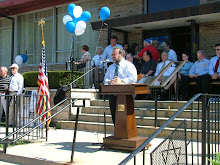OR LA YEHUDIM IYAR 5769
A Light to Our Fellow Jews in the Month of Iyar
YOM YERUSHALAYIM: 42ND ANNIVERSARY OF REUNIFIED JERUSALEM
On the site where the ancient Temple of Jerusalem stood, legend tells us two brothers once lived. The elder did not marry, and was all alone in the world. The younger had a wife and three children. The brothers had no material possessions except a plot of land which they inherited from their father. They did not want to divide up the land, because they loved each other. Instead, they worked it together, and when the harvest was over, they counted sheaves and divided them equally between them, placing them in two piles, each beside his own tent.
One year, after the harvest, the elder brother lay down to sleep beside his pile. But he could not fall asleep, because the thought ran through his mind: “My brother has a wife and children to care for, while I am alone in the world and work only to fill my own belly. It isn't right that I should take an equal share with my brother.” At midnight he got up, took some sheaves from his pile, stealthily went to his brother's pile and placed them there. Then he returned to his place and slept peacefully.
That same night, the younger brother was also unable to sleep. He thought: “My brother is all alone in the world. I have children who will look after me when I am old and unable to work. What will my brother do in his old age? It isn't fair of me to take an equal share of the produce of our field!” So before daybreak, the younger brother got up, took a few sheaves from his pile, stealthily placed them on his brother's pile, and returned to his place and slept.
In the morning, the brothers saw that their piles were as large as ever. They wondered greatly about this, but they did not say a word to each other. The same thing happened the next night and the morning that followed. On the third night, as the brothers were carrying sheaves to each others’ pile, they met midway, recognized each other, embraced, and wept, for they realized what had been happening. God saw what the brothers did and blessed the spot where they met. Later Solomon, King of Israel, built the holy Temple on that very spot - the Temple from which the message of peace, love and brotherhood went out to the whole world. As it says in the Book of Isaiah: "From Zion comes forth the Torah and the Word of God from Jerusalem ." (Isaiah 2:3)
As Jews, Jerusalem is not a city as any other. It is the Holy City , the dwelling place of the Shekhinah - the Divine Presence - the focal point of all that is Jewish. No words can adequately describe the profound 3000-year-old love affair of our people with this most special city. How can one capture the miracle, the mystery and the majesty of this city, when one is so confined by the limits of words. Words are a feeble instrument to describe the bond we, as a people - and hopefully as individuals - feel about Ir Shalem, the City of Peace .
In the 10th Century BCE, the city of Jebus was captured by King David, who made it the capital city of the United Israelite Kingdom and restored its name to Yerushalayim, proclaiming that, in accordance with Divine Will and through God's presence in this place, the Almighty will make the world shalem - complete, whole, tranquil, peaceful. Yerushalayim became the Holy City with the building of the First Temple by David's son, Solomon. Ever since, Yerushalayim has been the political and spiritual center of the Jewish people.
Today, Jerusalem is a short distance away. One can get there in less than two hours from Tel Aviv by car. One can get there in nine hours from New York by plane. But it was not always that way. In 1840, a man set out from Poland to Jerusalem to see the Holy City before he died. He left just after Sukkot. He arrived in Palestine - spent, sick and exhausted, just in time for Pesach - eighteen months later. He had crossed mountains and rivers and fought off robbers and diseases in order to get there. There were many such pilgrims in the nineteenth century.
Eighteen months - that is how long it used to take to get there. Now it is nine hours away.
The profound yearning for Zion and Jerusalem its Holy City, the urge to return and reestablish the Jewish state, and the faith that the vision of the Prophets would be fulfilled, has sustained the spirit of the Jewish people in all the countries of our dispersion. Throughout history, our religious writings have stressed the sacred obligation to come home to the Land of Israel and to remember the city of Jerusalem . Psalm 137 proclaims it best when it teaches: "If I forget you, O Jerusalem, let my right hand whither, let my tongue cleave to the roof of my mouth, if I remember you not, if I set not Jerusalem above my chiefest joy" (Psalm 137:5-6).
As we celebrate Yom Yerushalayim which commemorates the reunification of the city during the 1967 Six Day War, let us not forget the Holy City 's importance to our lives and to the psyche of our people. Let us pray that peace come speedily and in our day.
Rabbi Geoffrey J. Haber is the rabbi of Temple Emanu-El of Closter , New Jersey . This Dvar Torah was originally shared through the UJC Rabbinic Cabinet, May 2007.
Sunday, April 26, 2009
Subscribe to:
Post Comments (Atom)










No comments:
Post a Comment